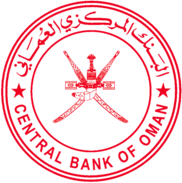 | |
| Headquarters | Ruwi, Muscat, Oman |
|---|---|
| Coordinates | 23°36′1″N 58°32′48″E / 23.60028°N 58.54667°E / 23.60028; 58.54667 |
| Established |
|
| Ownership | 100% state ownership |
| Chairman | Taimur bin Asa'ad al Said |
| Central bank of | Oman |
| Currency | Omani rial OMR (ISO 4217) |
| Reserves | US$17.19 billion |
| Website | www |
The Central Bank of Oman (CBO; Arabic: البنك المركزي العماني) was established in December 1974 and began operations on 1 April 1975. It replaced the Oman Currency Board as the principal currency authority in Oman. Currently it is headed by Taimur bin Asa'ad bin Tariq Al Said.
The Central Bank of Oman is responsible for maintaining the stability of the national currency the Omani Rial and ensuring monetary and financial stability in a deregulated and open financial system. The capital base of the CBO which was one million Omani Rials at the commencement of operations in 1975, was strengthened over time and since April 2002 has remained at ر.ع. 300 million. At the end of 2005, CBO's assets/liabilities totalled RO1826.4 million.
The Omani banking system has experienced several mergers since the 1990s and as a result the number of commercial banks at the end of 2005 stood at 13, of which five are locally incorporated and eight are branches of foreign banks, together having a branch network of 329 branches. Local banks, in addition, have 10 branches and one representative office abroad. As at the end of 2005, there were also three specialised banks in operation, with a network of 26 branches. The CBO has approved the establishment of an additional local bank (Sohar Bank) and a branch of a foreign bank (Bank of Beirut) that are expected to commence operations by the end of 2006. To strengthen the financial position of licensed banks and enable them to face competition as well as finance large projects, the minimum capital requirement for commercial banks was enhanced to RO50 million for local banks and RO10 million for foreign banks. The overall capital adequacy ratio of the commercial banks improved to reach 18.5 percent in 2005.
The Sultanate has made significant progress in implementing the new capital Adequacy criteria laid down in the Basel-II Accord. The adoption of Basel II would transform the current approaches and tools of supervision of the CBO as well as the audit and risk management practices of banks.
The CBO also administers and participates in the financing of a Bank deposit insurance system, which provides the commercial banks with a high level of security for deposits, while cushioning the effects of any unforeseen circumstances. The CBO also has an early warning system for commercial banks that enables it to predict possible financial crises and take preventive action when necessary.
The various monetary policy instruments under the CBO's command could be broadly categorized into indirect measures and direct measures. Indirect policy (market oriented) measures include open market operations involving the buying and selling of securities, issuance of Central Bank's own securities, swaps etc. CD auctions are the main open market type operations conducted by CBO to absorb Omani Rial liquidity and banks can repossess these CDs to acquire liquidity both in the inter-bank market as well as the CBO. Direct monetary policy instruments used by the CBO are mainly in the form of reserve requirements and lending ratios.
The CBO has put in place an efficient and advanced payment and settlement system in Oman. The launch of the Real-time gross settlement (RTGS) was the first milestone and went into live operations on 28 September 2005.
History
Until 1970, when Sultan Qaboos bin Said took over, there was no national authority responsible for the supervision of the incipient banking system. The number of banks was small and the banking activities were limited in scales. The two monetary authorities that preceded the establishment of the Central Bank of Oman, namely the Muscat Currency Authority in 1970 and the Oman Currency Board in 1972, were not vested with full banking status, but, they had well prepared the ground for the emergence of the Central Bank of Oman. However the major event heralding the eminent creation of the Central Bank of Oman was the launching of the Banking Law in 1974 (which was amended vide Royal Decree No. 114/2000).
Chairmen of the board
- Mahmood Muhammad Murad, of Oman Currency Board, 1972–1974
- Tariq bin Taimur, of Central Bank of Oman, 1974–1976
- Sultan Qaboos bin Said, 1976 – January 2020
- Sultan Haitham bin Tariq, January 2020 – August 2020
- Taimur bin Asa'ad al Said, August 2020–present
Executive presidents
- Yusuf A. Nimatallah, 1975 – Dec 1978
- Abdul Wahab Khayata, Dec 1978 – June 1991
- Hamood Sangour Al Zadjali, June 1991 – Sept 2017
- Tahir Salim Al Amri, Sept 2017 –
See also
References
- Weidner, Jan (2017). "The Organisation and Structure of Central Banks" (PDF). Katalog der Deutschen Nationalbibliothek.
- "Central Bank of Oman". cbo-oman.org. Retrieved 21 September 2016.
- Worldfolio, The. "Central Bank of Oman". theworldfolio.com. Archived from the original on 14 June 2017. Retrieved 21 September 2016.
- Newspaper, Muscat Daily. "14 banks operating in sultanate take part in bowling tournament – Oman". Muscat Daily News. Retrieved 2 December 2018.
- "European Central Bank total assets". doi:10.1787/888933169301.
{{cite journal}}: Cite journal requires|journal=(help) - "Central Bank of Oman launches its redesigned automated clearing house payment system". Times of Oman. Retrieved 2 December 2018.
- CBO-ITD. "Central Bank of Oman". cbo.gov.om. Retrieved 21 November 2017.
- "CBO welcomes His Highness Sayyid Taimur bin Asa'ad bin Tariq Al Said". www.cbo.gov.om. Central Bank of Oman.
- ^ Circular Booklet cbo.gov.om
- ^ Nagraj, Aarti (6 September 2017). "Oman replaces long-serving executive president of central bank".
| Central banks | |
|---|---|
| Global | |
| Policies | |
| Implementation | |
| Bretton Woods system | |
| Lists | |